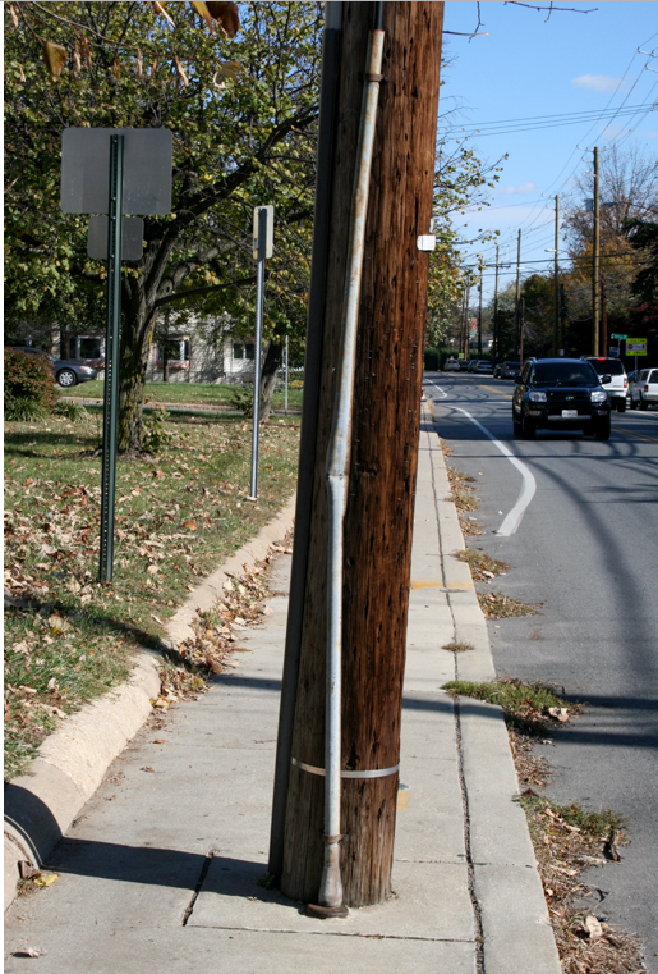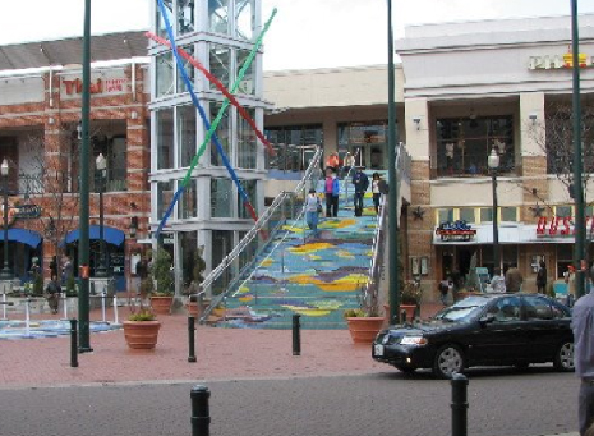guest post by Alex Hutchinson
If a car were blocking a major intersection, it would be towed within minutes. Yet this telephone pole gets a free pass despite being directly in front of the Silver Spring Police Station.
Walk around Silver Spring and you’re likely to notice the numerous light poles, parking meters, and electrical boxes inconveniently placed in the middle of sidewalks and curb ramps.
Through a comprehensive set of sidewalk and street improvements, we can restore equal access while promoting healthy walkable communities.
Planners and traffic engineers are spreading the gospel of complete streets – streets that provide equal access to bicycle, pedestrian, transit, or car users regardless of age or ability. Complete streets include wide sidewalks, bike lanes, frequent crossing opportunities, median islands, and more.
A few weeks ago, The Coalition for Smarter Growth hosted Ian Lockwood, a transportation expert who talked about complete streets and the communities in the United States and Canada he has helped fix. Lockwood was a consultant on the recently approved White Flint Sector Plan.
One of Lockwood’s counterintuitive ideas is the concept of shared streets. Streets that seemingly lack any organization: no signs, lanes, crosswalks, speed limits, stop lights or curbs.
Lockwood doesn’t say that we should take all the street signs down. Rather, roads must be strategically redesigned for slower, but better-flowing travel. This requires a new set of cues. Raised brick crosswalks are a common shared-space method for slowing cars at intersections because they provide a visual and tactile signal for motorists to brake and watch for pedestrians. Lockwood explains that changes in textures, paving materials, trees, or colors allow streets to dictate the rules of the road better than any sign.
Silver Spring’s Ellsworth Drive is a great example of this. When the street is open to traffic (only on weekdays), cars move at a leisurely pace – creating a safe environment for pedestrians of all types. The varying surface from brick to asphalt keeps drivers alert and aware of their surroundings.
Downtown Silver Spring has many of the critical features that Lockwood emphasizes for successful shared spaces: a good street network, buildings that hold the street, lots of pedestrians and cycling, and a vibrant environment for entertainment and social contact. This idea of shared spaces could very well be applied to the Fenton/Wayne intersection.
Many curbs and sidewalks across Silver Spring are being repaired to better accommodate wheelchairs and pedestrians of all types. But awkwardly placed telephone poles, light posts, and even bus stops show many are still in need of work.
William Smith is a Silver Spring resident who has taken matters into his own hands. Smith, who is legally blind, is the founder of the blog Montgomery Sideways, which documents the shortcomings of Silver Spring sidewalks. Smith meticulously records and posts the locations of problem areas on Google maps in hopes that improvements can be made for the disabled. “Crossing the street in this town is downright dangerous,” he says. “The simple act of walking down the street can be an ankle-busting experience for anyone – especially a blind guy.”
The complete street approach is the most sensible and effective option for improving accessibility. By continuing to improve the sidewalks, removing thoughtlessly placed infrastructure, creating shared spaces, slowing down traffic speed and improving our public transportation, we can restore equity to those who are less mobile.
It might be simple, but Silver Spring’s solution to the future is the oldest form of transportation: walking.

